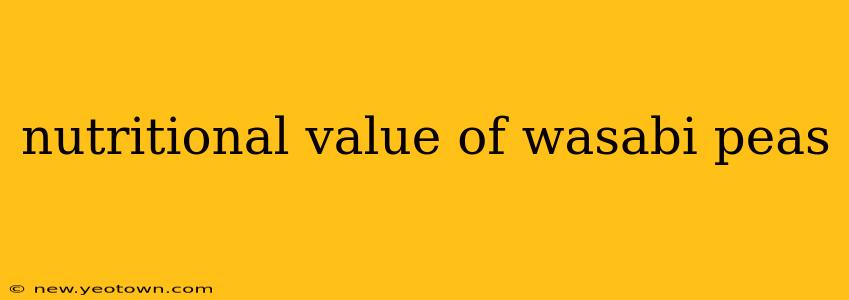Wasabi peas. That vibrant green, delightfully spicy snack that seems to vanish from the bowl faster than you can say "umami." But beyond their addictive crunch and fiery kick, what's actually in these little green gems? Let's delve into the surprising nutritional value of wasabi peas and uncover why they might deserve a spot (in moderation, of course!) in a balanced diet.
My name is Alex, and I've been fascinated by the intersection of food and health for years. I'm not a registered dietitian, but I've spent countless hours researching the nutritional content of various foods, and I'm excited to share my findings on this popular snack. This information is for general knowledge and shouldn't replace advice from a healthcare professional.
What are Wasabi Peas Made Of?
Before diving into the nutritional details, let's understand the basic ingredients. While the exact recipe can vary by brand, wasabi peas typically consist of:
- Green peas: These are the base, providing the majority of the nutritional value.
- Vegetable oil: Usually soybean or canola oil, contributing to the satisfying crunch.
- Salt: A significant contributor to the overall sodium content.
- Wasabi powder (or flavoring): This delivers the signature spicy kick, though the amount of actual wasabi can be surprisingly low in many brands. Often, other spices and flavor enhancers are added to mimic the wasabi taste.
- Other seasonings: Depending on the brand, you might find things like sugar, MSG (monosodium glutamate), and various artificial colors and flavors.
Are Wasabi Peas Healthy?
This is the million-dollar question. The answer, like many things in nutrition, is: it depends. While wasabi peas offer some nutritional benefits, they shouldn't be considered a health food. Their high calorie and sodium content make them more of an occasional treat than a staple.
What are the Nutritional Benefits of Wasabi Peas?
Despite their limitations, wasabi peas do offer some positive aspects:
- Fiber: Peas are a good source of dietary fiber, which aids in digestion and can contribute to feelings of fullness.
- Protein: While not a significant protein source, they contribute a small amount to your daily intake.
- Vitamins and Minerals: Peas contain small amounts of various vitamins and minerals, including vitamin K, vitamin C, and iron. However, the processing involved in making wasabi peas might reduce the bioavailability of some of these nutrients.
- Antioxidants: Peas, especially when minimally processed, contain antioxidants that can help protect cells from damage.
How Many Calories are in Wasabi Peas?
The calorie count can vary based on brand and serving size, but a typical 1-ounce serving (about a small handful) contains around 150-170 calories. It’s easy to overconsume them, so portion control is key.
How Much Sodium is in Wasabi Peas?
This is a significant concern. Wasabi peas are notoriously high in sodium. A single serving often contains 20% or more of the recommended daily sodium intake. This can be detrimental to those with high blood pressure or other health concerns.
Are Wasabi Peas Gluten-Free?
Generally, yes. Wasabi peas are usually made with pea flour, which is naturally gluten-free. However, always check the ingredient list to ensure that there are no added gluten-containing ingredients.
Are Wasabi Peas Keto-Friendly?
This depends on your personal macro targets. While peas are relatively low in carbohydrates compared to some other legumes, a serving of wasabi peas can still contribute a significant amount of carbohydrates to a ketogenic diet.
Are Wasabi Peas Vegan?
Most brands of wasabi peas are vegan, as the ingredients are typically plant-based. Always check the ingredient list to be certain there are no animal products included.
In conclusion, wasabi peas can be a fun and flavorful snack, but they are not a nutritional powerhouse. Enjoy them in moderation, mindful of their high sodium and calorie content. And remember, a balanced diet and a healthy lifestyle are far more important than relying on any single snack for nutritional benefits.

